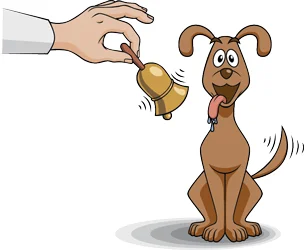Classical Conditioning: the learning process that connects a meaningful “stimulus” (such as the smell of food to a hungry animal) with a “neutral stimulus” (such as the sound of a bell). (Berger, 39)
Involves repeatedly pairing a neutral stimulus with a response-producing stimulus, until the neutral stimulus elicits the same “response.“ (Hockenbury, 176) A type of learning in which a neutral stimulus acquires the capacity to trigger a particular response by becoming paired with an unconditioned stimulus. (Collin, 340) In his now famous study of salivation in dogs, Russian physiologist Ivan Pavlov described how an animal responds to a stimulus in the process of conditioning, and gave psychologists the foundation on which to build the central idea of “behaviorism." (Collin, 58) Also referred to as ‘Pavlovian conditioning’ and ‘respondent conditioning.’
Response: the reaction of an “organism” in the presence of some stimulus. (Cardwell, 208) Any act or phenomena, or behavior, constituting a reply or reaction of a living organism, or its part, to some foregoing stimulus or agent. (NCIt) The way in which the body or part of the body reacts to a stimulus. For example, a nerve “impulse” may produce the response of a “contraction” in a “muscle” that the nerve supplies. (OxfordMed) Editor's note - also refers to commands sent down to the “central nervous system” from the “cerebral cortex” and to other various cellular responses.
Conditioned Response: the learned, reflexive response (dog salivating) to an "conditioned stimulus." (Hockenbury, 176) A learned response elicited by a conditioned stimulus. (Coon, 365) A particular response elicited by an initially neutral stimulus that has been paired with an unconditioned stimulus, which naturally provokes that response. (Collin, 340)
Unconditioned Response: the unlearned, reflexive response that is elicited by an unconditioned stimulus (Hockenbury, 176) An innate reflex response elicited by an unconditioned stimulus. (Coon, 265)
Stimulus: a term used in psychology that has the following characteristics: has some physical reality (such as a sound or a smell); is capable of stimulating the “sensory” organs of the organism receiving it; stimulates some response from the organism; is predominantly ‘external’ in origin. (Cardwell, 240) Any object, event, situation, or factor in the environment that an individual can detect and respond to. (Collin, 343)
Conditioned Stimulus: when a "neutral stimulus" becomes associated with an "unconditioned stimulus," thus triggering a conditioned response. (Kleinman, 10) A stimulus that evokes a response because it has been repeatedly paired with an unconditioned stimulus. (Coon, 265) A formerly neutral stimulus that acquires the capacity to elicit a reflexive response. The stimulus that is originally neutral but comes to elicit a reflexive response. (Hockenbury, 176-177)
Neutral Stimulus: a stimulus that is not related to a response. (Kleinman, 10) A stimulus that does not evoke a response. (Coon, 265) A stimulus that has no meaning prior to conditioning (Berger, 39)
Stimulus Discrimination: an aspect of classical conditioning where an organism responds to one stimulus while losing the tendency to respond to similar stimuli. (Cardwell, 241) The learned ability to respond differently to similar stimuli. (Coon, 267) The occurrence of a learned response to a specific stimulus but not to other similar stimuli. (Hockenbury, 179) For example, a young child was frightened by a deranged Chihuahua which nipped him on the leg. Because of the incident, he developed a strong fear of small dogs, but not large dogs. (Hockenbury2, 5)
Stimulus Generalization: an aspect of classical conditioning whereby an organism not only responds to the conditioned stimulus, but also to stimuli that are similar to the conditioned stimulus (Cardwell, 241) The tendency to respond to stimuli similar to, but not identical to, a conditioned stimulus. (Coon, 267)The occurrence of a learned response not only to the original stimulus, but to other, similar stimuli as well. (Hockenbury, 179) For example, a young child learned to associate the sight of a nurse’s white uniform with the fear and pain of getting an injection. The young child begins reacting with fear to the sight of any white jacket. (Hockenbury2, 5)
Unconditioned Stimulus: a stimulus innately capable of eliciting a response. (Coon, 265) The natural stimulus that reflexively elicits a response without the need for prior learning. (Hockenbury, 176) A stimulus that elicits a reflexive (natural) response. (Collin, 343)
